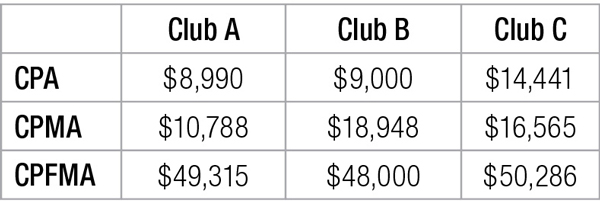
Ridgewood Country Club in Paramus, N.J., where author Todd W. Raisch, CGCS, has been the superintendent since 1996. Ridgewood’s 27 holes were designed by A.W. Tillinghast and opened in 1929. Photo by Evan Schiller
Every fall it happens, just like clockwork: We present a budget for the upcoming season, and in the first meeting with the finance committee, the treasurer begins talking about cost-per-hole statistics provided by auditors or local golf associations. My response is often the same: “I could write a book as to why cost-per-hole is a bad metric.”
OK, so maybe not a book, but at least the next several paragraphs.
Consider the case of three private clubs in northern New Jersey, all with similar course conditioning standards.
• Club A is an 18-hole venue with a budget of $1,726,000. The standard cost-per-hole formula (budget divided by number of holes) yields a cost per hole of $95,888.
• Club B also features 18 holes and has a budget of $1,800,000. Cost per hole: $100,000.
• Club C has 27 holes and a budget of $2,816,000. Cost per hole: $104,296.
A cursory look at the numbers above shows Club C as the most expensive maintenance operation, as it spends the most money. The cost-per-hole metric backs this up, with Club C having the highest cost per hole.
In these terms, Club A is the best value and Club C is the least efficient.
But is it really true that Club C is the least efficient? A more nuanced view of these numbers might reveal a different result if more variables are considered.
Why does cost-per-hole vary?
There are myriad reasons why one course’s cost-per-hole might be larger or smaller than those of similar courses in close proximity. The number of intrusive trees, grass varieties, drainage characteristics, size of practice facilities, labor availability, number of rounds, cart usage, etc., all play a significant role in maintenance costs.
However, in a recent GCSA of New Jersey operating budget survey of 54 member courses, four line items showed a prodigious capacity to skew the cost-per-hole metric. While salaries, chemicals and topdressing are included in 100% of all operating budgets, it is not necessarily true that all grounds budgets include the following four items. These expenses can easily be responsible for 10% to 20% of the operating budget.
Water expense. Ten of 54 courses (19%) surveyed do not pay for their water usage, and 11 of 54 (20%) buy water with yearly costs ranging from $8,000 to $223,000. The majority — 33 of 54 (61%) — pay the New Jersey Department of Environmental Protection a yearly fee averaging approximately $4,000 for the right to draw a specific maximum number of gallons from wells, ponds or rivers.
Employee benefits. While this line item was not surveyed, it is commonly accepted that not all courses include health benefits and other perks in the grounds budget. Those are often included in general and administrative budgets. Furthermore, an apples-to-apples comparison of benefits is difficult, as each course varies wildly in what it provides its employees. One course may not provide retirement benefits such as a matching 401(k), and another course may do so with as much as an 80% to 100% match of employee contributions. Benefits can range from tens of thousands per course to several hundred thousand dollars for bigger clubs.

The cost of water is one variable for which the most basic cost-per-hole formula does not account. Factoring in water costs can allow for a fairer comparison of courses. Photo by Evan Schiller
Utilities. Of 54 courses surveyed, 25 (46%) do not have utilities included in the grounds budget. This item can quickly approach $100,000 at large courses, mostly because of the electricity necessary to run irrigation pumps.
Leased equipment expense. Perhaps the biggest impediment to an apples-to-apples comparison of courses is how equipment is expensed. Of 54 courses, 26 (48%) included some kind of leased-equipment expense in their operating budgets. Expenditures ranged from $2,300 per year to $319,000 per year. It’s not that the other 28 courses did not spend monies on new equipment; they instead purchased the equipment outright and capitalized the expense.
An apples-to-apples comparison
Let’s look at our three examples again considering these variables. None of the courses counts benefits against its grounds budget.
Club A pays $112,000 for water, while Club B pays $4,500 and Club C budgets $4,000.
Club A purchases its equipment outright and has no leased-equipment expenses. Club B budgets $18,000 for leased equipment, while Club C spends $230,000.
Removing these factors tells a different story than simply dividing operating budget by the number of holes.
Club A
($1,726,000 - $112,000)/18 = $89,667 per hole
Club B
($1,800,000 - $4,500 - $18,000)/18 = $98,750 per hole
Club C
($2,816,000 - $4,000 - $230,000)/27= $95,629 per hole
Club B now becomes the most expensive on an apples-to-apples basis, while Club A remains the most efficient. Club C is now the second most efficient and would close the gap even more with Club A if utilities were used as part of this calculation, as Club A does not include utilities in the grounds budget, but Club C does.
But again I ask, even after removing the manipulating factors, does this tell the whole story? After all, despite Club A’s disadvantage with the need to purchase such a large quantity of water and Club C’s large leased-equipment expense, both of which hurt their cost-per-hole metric, these are indeed legitimate operating expenses.
3 ways to compare golf course costs
Perhaps there are better ways to compare one course’s expenditures with those of the course down the street. In addition to cost per hole, let’s look at cost per acre, cost per maintained acre and — in my opinion, the most important metric — cost per finely maintained acre.
First, the definitions:
• Cost per acre (CPA): total operating expenses divided by total property acres.
• Cost per maintained acre (CPMA): total operating expenses divided by total maintained acres (rough included, but not native areas).
• Cost per finely maintained acre (CPFMA): total operating expenses divided by total acres of greens, tees and fairways.
To calculate these metrics, we need a few more details:
• Club A encompasses 192 total acres, with 160 maintained acres and 35 finely maintained acres.
• Club B covers 200 acres, with 95 maintained acres and 37.5 finely maintained acres.
• Club C has 195 acres, 170 maintained acres and 56 finely maintained acres.
Calculating using our new metrics, we get:

By viewing operating budget comparisons based on what parts of the golf course matter most — greens, tees and fairways — we now see that Club B is the most efficient, with $48,000 spent per acre vs. $49,315 for Club A and $50,286 for Club C.
Of course, there are still those nagging manipulators that prevent a fair comparison among courses. When we remove those variables (in this example, water and leased-equipment expenses) and apply our new CPFMA metric, we come up with:
Club A
($1,726,000 - $112,000)/35 = $46,115 CPFMA
Club B
($1,800,000 - $4,500 - $18,000)/37.5 = $47,400 CPFMA
Club C
($2,816,000 - $4,000 - $230,000)/56 = $46,107 CPFMA
Therefore, Club C — which, using the original, less refined cost-per-hole metric, was initially considered the least efficient club — is now the most efficient at $46,107, with Club A close behind. All clubs are within $1,293 of each other on the basis of finely maintained acres, suggesting that all the superintendents are properly managing their budgets to the level of their competition in terms of course expectations.
Cost-per-hole is a tired and overly simplistic metric to compare one course’s maintenance operations budget with another’s. It does not properly discriminate between critical differences in course makeup and budget design.
Considering variables that may be unduly influencing this number and using more refined metrics will provide your course with a better comparison to neighboring courses.
Todd W. Raisch, CGCS, has been the superintendent at Ridgewood Country Club in Paramus, N.J., since 1996. He is a 26-year GCSAA member.